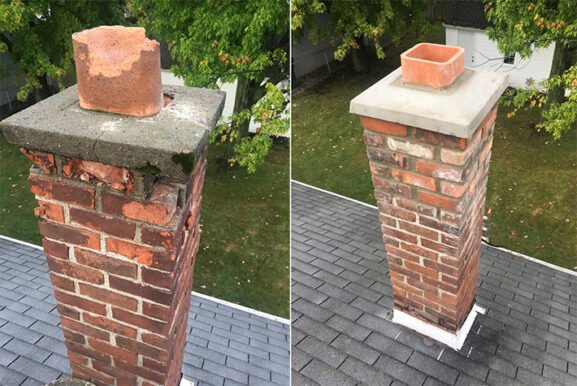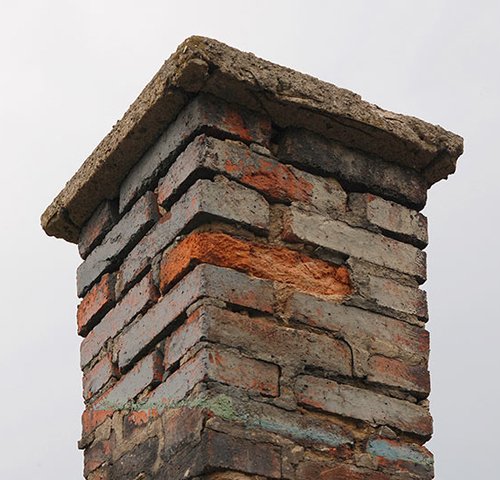Understanding Chimney Cap Repair Cost and What Influences It
Key Takeaways
- Chimney cap repair costs typically range between $150 and $700 depending on materials, labor, and damage extent
- Delaying chimney cap repairs can lead to more expensive structural or water damage
- Materials like stainless steel or copper increase costs but offer longer-term protection
- Professional inspections can help detect hidden issues that raise long-term repair expenses
Why the Chimney Cap Matters More Than You Think
The chimney cap may seem like a small feature, but it plays a big role in keeping your fireplace system functioning safely and efficiently. It sits at the very top of your chimney and protects the flue from rain, snow, animals, debris, and downdrafts. When the cap is damaged or missing, water can leak into your chimney structure, accelerating brick and mortar deterioration, rusting metal components, and even creating mold issues in the walls or attic. This is why understanding chimney cap repair cost is essential for homeowners who want to stay ahead of more serious, costly issues.
Typical Price Range for Chimney Cap Repair
Most homeowners spend between $150 and $700 for chimney cap repair. The total can vary depending on whether the cap needs a simple reseal, a partial replacement, or a full reinstall. If rust or corrosion has set in, the entire cap may need to be removed and replaced, which drives up labor and material costs. In cases where additional structural damage is found, like crumbling masonry or a cracked crown, the repair bill can exceed $1,000.
These price points cover both materials and labor. Basic galvanized steel caps are more affordable, while higher-end stainless steel or copper caps can cost significantly more due to their durability and appearance.
What Affects the Total Cost of Chimney Cap Repairs
Type and Material of the Chimney Cap
The material you choose has a direct impact on the overall cost. Galvanized steel is the most affordable option but tends to rust and wear out faster. Stainless steel is more resistant to weathering and corrosion, while copper, though expensive, offers excellent longevity and aesthetics.
Concrete caps that are built into the structure of masonry chimneys are typically more expensive to repair since they often require more specialized labor and tools. In some cases, repairing a concrete cap also involves crown sealing or resurfacing.
Height and Accessibility of the Chimney
A tall or steep roof adds to the labor costs due to the additional time, tools, and safety equipment required. Chimneys that are harder to access might require scaffolding or specialized ladders, which increases the complexity and cost of the repair.
If your chimney is three stories or higher, expect to pay more for the service. Roof pitch and local building codes may also factor into the pricing because of safety requirements.
Extent of the Damage
A minor crack or loose fastener can often be fixed quickly and affordably. But if water damage has already begun to spread into the flue liner, bricks, or surrounding areas, additional work may be needed. Moisture trapped inside the chimney can degrade metal dampers or cause the flue lining to separate.
Sometimes, what looks like a simple chimney cap issue is actually a sign of deeper structural problems. That’s why it’s important to have a full inspection conducted by a licensed chimney technician before any repairs begin.
When Repairs Turn Into Full Replacements
In some cases, repairing a chimney cap isn’t feasible. Rust, denting, or separation from the crown may leave the cap unable to do its job, and replacement becomes the smarter long-term solution. Full replacements can range from $300 to $1,000 or more depending on material and labor.
This is especially true for older homes with outdated or ill-fitting chimney caps. Modern custom-fitted caps provide better protection and airflow regulation, reducing the chance of recurring issues. Replacing an older cap may seem expensive upfront but often saves money over time by preventing more extensive damage.
How Local Weather and Environment Impact Repair Needs
Homes in areas with heavy rainfall, snow, or strong winds tend to experience more frequent chimney cap issues. Constant exposure to moisture can cause rust or ice damage, especially in cheaper materials like galvanized steel. Similarly, regions with a lot of falling leaves, pine needles, or bird activity see more debris blockages.
For example, in places like the Northeast or Pacific Northwest where winters are harsh and wet, chimney caps often degrade faster and require earlier repairs. According to the National Weather Service, weather patterns play a major role in structural degradation due to water infiltration and freeze-thaw cycles.
Knowing your regional climate helps anticipate how often your chimney system might need servicing, and what materials may hold up better in your environment.
Why Routine Inspections Make a Difference
Having your chimney inspected at least once a year by a qualified technician can catch early signs of cap wear or water intrusion. This proactive step costs much less than dealing with repairs once water damage has taken root in the structure.
A full inspection typically includes checking the flue liner, masonry, crown, flashing, and of course, the cap itself. Certified chimney sweeps often use video scanning tools to examine parts of the system that are not visible from the roof. These checks are especially valuable after major storms or long winters.
Small issues like surface rust, animal nests, or missing screws can be corrected on the spot. This level of attention helps avoid surprises and unplanned repair bills in the future.
Considering DIY vs Professional Repairs
While some handy homeowners might be tempted to tackle chimney cap repairs on their own, this isn’t always recommended. Working on a roof comes with safety risks, and improperly installed caps can lead to continued leaks, draft issues, or even structural failures.
Professionals bring not only experience and safety equipment but also a trained eye to catch problems that may be missed during a casual inspection. In many cases, the job requires sealants rated for high temperatures, specialized fasteners, or fabrication of custom components — all better left to licensed technicians.
Unless you’re trained and confident working at height with chimney systems, hiring a professional is usually the more cost-effective and safer route.
Budgeting Smartly for Long-Term Chimney Protection
If you’re planning out home maintenance expenses, chimney cap repair should be factored in along with routine roof inspections, gutter cleaning, and HVAC servicing. While the cost may seem like a low priority, it’s often a key piece of protecting your larger home investment.
Consider setting aside a modest annual budget for chimney maintenance. This allows for regular inspections, minor repairs, or early replacements before the issues compound. A chimney cap that’s well maintained supports better indoor air quality, reduces energy waste, and keeps pests and moisture out.
Homeowners who keep a long-term maintenance plan in place typically pay less over the years because they’re not constantly dealing with emergencies or water-related damage.
Making the Most of Professional Evaluations
Choosing the right professional for your chimney cap repair is just as important as the work itself. Make sure the contractor is certified by organizations such as the Chimney Safety Institute of America (CSIA) or the National Fireplace Institute. Ask for detailed estimates that include a breakdown of labor, materials, and additional services.
A reputable professional will not only repair or replace your chimney cap but also provide insights into your chimney system’s overall health. This evaluation can reveal whether other areas need attention, giving you time to plan ahead rather than deal with unexpected problems later.
When repairs are handled thoroughly and promptly, a high-quality chimney cap can last for decades with minimal upkeep. That’s why it pays to approach chimney cap repair as a smart, preventive measure rather than a reactive expense.
Planning Ahead for Safer and Smarter Repairs
If your chimney cap is showing signs of rust, looseness, or water stains are appearing near your fireplace, it’s time to take action. Addressing the issue early not only keeps repair costs manageable but also protects the entire chimney system from long-term damage. A small fix today could prevent a much bigger, more expensive repair in the future.
Whether you’re dealing with a minor crack or full cap deterioration, understanding the true cost of chimney cap repair helps you make informed, confident decisions about your home’s safety and longevity.

